As the world moves toward clean energy sources, a group of researchers at Princeton University have completed a study involving artificial intelligence (AI) and fusion energy.
As per a CNN report, the study involves using AI to predict real-time instabilities associated with attempts to achieve fusion energy. While touted as a solution to the climate crisis, scientists have been unable to achieve sustained fusion energy given the complexities associated with the process.
Several strategies were done to achieve fusion energy, but the most common and plausible of all involves using hydrogen variants as fuel and raising temperatures to high levels in a donut-shaped machine—known as tokamak—to produce plasma. Nuclear energy researchers are facing the uphill climb of restraining the plasma within the confines of the device’s magnetic fields given its tearing properties.
“This is one of the big roadblocks — disruptions — and you want any reactor to be operating 24/7 for years without any problem,” said project’s author Egemen Koleman, a professor of mechanical and aerospace engineering at Princeton University. “And these type disruption and instabilities would be very problematic, so developing solutions like this increase their confidence that we can run these machines without any issues.”
The team’s AI model demonstrated advanced capabilities in predicting plasma tears in advance, a key factor in keeping the fusion reaction going. Per the research paper, the system gave warnings for potential plasma tears by 300 milliseconds before the occurrence of the event.
“The experiments provide a foundation for using AI to solve a broad range of plasma instabilities, which have long hindered fusion energy,” said a Princeton University representative.
Previous studies involving nuclear fissions have shown promise, with one U.K.-based experiment recording 69 megajoules of fusion energy for five seconds. While the energy generated can power over 12,000 households, the study used more energy than it created.
To make fusion energy commercially available, researchers are pinning their hopes on integration with emerging technologies as optimists predict 2040 for mainstream rollout.
Nuclear energy and AI
While scientists are leveraging AI to extend the duration of fusion reactions, several technology firms are keen on using the energy source to power their AI ambitions.
A Microsoft (NASDAQ: MSFT) job listing revealed plans for the technology giant to build small modular reactors (SMRs) as alternative energy sources for its AI objectives. Pivoting to SMRs will not be a walk in the park for Microsoft, given the scarcity of advanced uranium fuel and the absence of an SMR design.
In the U.K., authorities are pushing for strict AI regulation in the same manner as the guardrails for nuclear energy, calling for an interventionist approach.
“My real point of concern is the lack of any regulation of the large language models that can then be applied across a range of AI tools, whether that’s governing how they are built, how they are managed, or how they are controlled,” said Labour Party MP Lucy Powell June 2023.
In order for artificial intelligence (AI) to work right within the law and thrive in the face of growing challenges, it needs to integrate an enterprise blockchain system that ensures data input quality and ownership—allowing it to keep data safe while also guaranteeing the immutability of data. Check out CoinGeek’s coverage on this emerging tech to learn more why Enterprise blockchain will be the backbone of AI.
Watch: Turning AI into ROI

 07-08-2025
07-08-2025 





